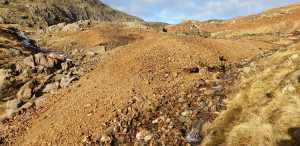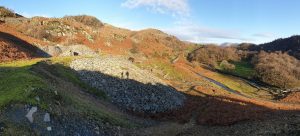Greenburn and Tilberthwaite have been extensively mined for heavy metals over the years for industry purposes. The residual deposits however, otherwise known as mine spoils or heaps are having a negative impact on the water quality downstream of the these mine sites. This initial feasibility study will establish a monitoring programme, informing the design options for potential future works to reduce water course connection to the heavy metal deposits.
A heavy metal monitoring programme was undertaken in the Little Langdale valley (downstream of the Greenburn mine) by South Cumbria Rivers Trust in 2017. This identified high levels of copper and other heavy metals downstream of the mine. To reduce the impact, further scoping is required at the source to understand where the main inputs are and identify the options to reduce this. Similarly, Yewdale beck, downstream of Tilberthwaite and Penny Rigg mines, is classed as moderate under the Water Framework Directive, with a reason for failure being stated as point source pollution from abandoned mines. The Upper Brathay, downstream of Greenburn mine, is classed Good, however, was Moderate in 2014 and is therefore at risk of deterioration; metal concentrations have been detected in this system. Greenburn mine is also upstream of Little Langdale Tarn SSSI, this open water unit is classed as unfavourable declining with water pollution identified with mining being a potential contributor. Furthermore, the mine sites are recognised nationally, for their historic significance, therefore any works must encompass environmental and heritage drivers.
Four mines sites in the Upper Coniston & Little Langdale area have been selected for further monitoring and scoping. These are:
o Greenburn Mine
o Tilberthwaite Mine
o Penny Rigg Mine
o Hawkrigg



Initial scoping visits have already been undertaken by South Cumbria Rivers Trust (SCRT), the National Trust (NT) and the Environment Agency (EA), however, a monitoring programme and further research will help build evidence and design a series of solutions to reduce heavy metal input in the watercourses and protect the Ancient Scheduled Monuments on site. A reduction in metal concentrations in the becks, will improve water quality and providing a better habitat for local species to survive, including invertebrates and fish such as salmonids and bullhead.
Project objectives
• Implement a monitoring programme of at least 6 sample sites across the 4 mine sites to identify heavy metal hotspots.
• Identify and produce a report outlining the best solution for each of the 4 mines sites.
The National Trust and other partners are also developing a valley restoration project in the Yewdale area. Therefore, improving water quality upstream would be a vital part of this whole-scale approach.
This is a South Cumbria Rivers Trust (SCRT) led project in partnership with the Environment Agency, National Trust and Lake District National Park. Funding had been provided through the Environment Agency Partnership grants scheme.


